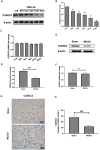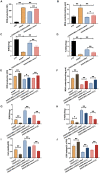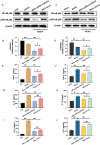CUEDC2 ablation enhances the efficacy of mesenchymal stem cells in ameliorating cerebral ischemia/reperfusion insult
- PMID: 33494071
- PMCID: PMC7906146
- DOI: 10.18632/aging.202394
CUEDC2 ablation enhances the efficacy of mesenchymal stem cells in ameliorating cerebral ischemia/reperfusion insult
Abstract
Mesenchymal stem cell (MSC) therapy has been reported to be a promising therapeutic option for cerebral ischemia/reperfusion (I/R) insult. However, the poor survival rate of engrafted MSCs under unfavorable cerebral I/R-induced microenvironment inhibits their efficiency during clinical application. CUE domain-containing 2(CUECD2) exhibits its protective role on cardiomyocytes by mediating the antioxidant capacity. Our study explored the functional role of CUEDC2 in cerebral I/R challenge and determined whether CUECD2-modified MSCs could improve the efficacy of treatment of the insulted neurons. We also evaluated the possible mechanisms involved in cerebral I/R condition. Cerebral I/R stimulation suppressed CUEDC2 levels in brain tissues and neurons. siRNA-CUEDC2 in neurons significantly inhibited cerebral I/R-induced apoptosis and oxidative stress levels invitro. Moreover, siRNA-CUEDC2 in the MSCs group remarkably enhanced the therapeutic efficacies in cerebral I/R-induced neuron injury and brain tissue impairment when compared to the non-genetic MSCs treatment group. At the molecular level, siRNA-CUEDC2 in MSCs markedly enhanced its antioxidant and anti-inflammatory effect in co-cultured neurons by upregulating glutathione peroxidase 1 (GPX1) expression levels while suppressing NF-kB activation. These findings provide a novel strategy for the utilization of MSCs to promote cerebral ischemic stroke outcomes.
Keywords: CUEDC2; MCAO; MSCs; OGD/R.
Conflict of interest statement
Figures








Similar articles
-
Effects of the Insulted Neuronal Cells-Derived Extracellular Vesicles on the Survival of Umbilical Cord-Derived Mesenchymal Stem Cells following Cerebral Ischemia/Reperfusion Injury.Oxid Med Cell Longev. 2020 Jul 16;2020:9768713. doi: 10.1155/2020/9768713. eCollection 2020. Oxid Med Cell Longev. 2020. PMID: 32724498 Free PMC article.
-
CUEDC2 modulates cardiomyocyte oxidative capacity by regulating GPX1 stability.EMBO Mol Med. 2016 Jul 1;8(7):813-29. doi: 10.15252/emmm.201506010. Print 2016 Jul. EMBO Mol Med. 2016. PMID: 27286733 Free PMC article.
-
Exosomes derived from PEDF modified adipose-derived mesenchymal stem cells ameliorate cerebral ischemia-reperfusion injury by regulation of autophagy and apoptosis.Exp Cell Res. 2018 Oct 1;371(1):269-277. doi: 10.1016/j.yexcr.2018.08.021. Epub 2018 Aug 22. Exp Cell Res. 2018. PMID: 30142325
-
Neuroprotection by mesenchymal stem cell (MSC) administration is enhanced by local cooling infusion (LCI) in ischemia.Brain Res. 2019 Dec 1;1724:146406. doi: 10.1016/j.brainres.2019.146406. Epub 2019 Aug 24. Brain Res. 2019. PMID: 31454517 Review.
-
Potential Signal Pathways and Therapeutic Effects of Mesenchymal Stem Cell on Oxidative Stress in Diseases.Curr Pharm Des. 2025;31(2):83-94. doi: 10.2174/0113816128308454240823074555. Curr Pharm Des. 2025. PMID: 39257144 Review.
Cited by
-
Therapeutic potential of mesenchymal stem cells for cerebral small vessel disease.Regen Ther. 2024 Feb 22;25:377-386. doi: 10.1016/j.reth.2023.11.002. eCollection 2024 Mar. Regen Ther. 2024. PMID: 38414558 Free PMC article. Review.
-
Mesenchymal stem cell therapy for neurological disorders: The light or the dark side of the force?Front Bioeng Biotechnol. 2023 Feb 28;11:1139359. doi: 10.3389/fbioe.2023.1139359. eCollection 2023. Front Bioeng Biotechnol. 2023. PMID: 36926687 Free PMC article. Review.
-
UBIAD1 alleviates ferroptotic neuronal death by enhancing antioxidative capacity by cooperatively restoring impaired mitochondria and Golgi apparatus upon cerebral ischemic/reperfusion insult.Cell Biosci. 2022 Apr 4;12(1):42. doi: 10.1186/s13578-022-00776-9. Cell Biosci. 2022. PMID: 35379328 Free PMC article.
-
Neuroprotection of Human Umbilical Cord-Derived Mesenchymal Stem Cells (hUC-MSCs) in Alleviating Ischemic Stroke-Induced Brain Injury by Regulating Inflammation and Oxidative Stress.Neurochem Res. 2024 Oct;49(10):2871-2887. doi: 10.1007/s11064-024-04212-x. Epub 2024 Jul 18. Neurochem Res. 2024. PMID: 39026086
-
Treatment of ischemic stroke with modified mesenchymal stem cells.Int J Med Sci. 2022 Jun 27;19(7):1155-1162. doi: 10.7150/ijms.74161. eCollection 2022. Int J Med Sci. 2022. PMID: 35919816 Free PMC article. Review.
References
Publication types
MeSH terms
Substances
LinkOut - more resources
Full Text Sources
Other Literature Sources
Molecular Biology Databases
Miscellaneous

